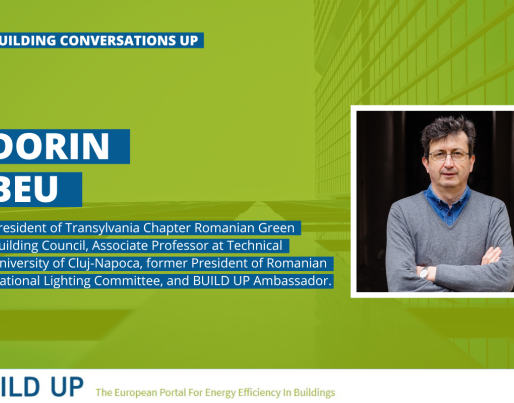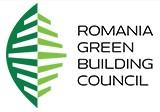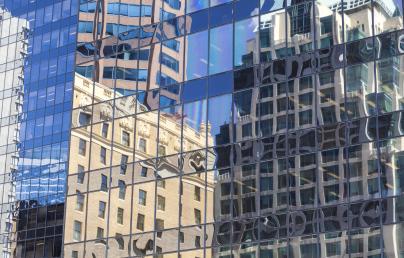Dorin Beu: “In energy efficiency of the building sector there are no miracle solutions, but you can reach energy goals with a good design and implementation”

Dorin Beu: “In energy efficiency of the building sector there are no miracle solutions, but you can reach energy goals with a good design and implementation”
BUILDING CONVERSATIONS UP WITH... Dorin Beu, President of Transylvania Chapter Romanian Green Building Council (www.rogbc.org), Associate Professor at Technical University of Cluj-Napoca, former President of Romanian National Lighting Committee, and BUILD UP Ambassador.
Dorin served as the Director of the Romanian Green Building Council (RoGBC) Transylvania Chapter since its founding in 2009 and is charged with implementing the European Energy Award for Romanian cities, Romanian manager for the H2020 projects COME Easy and EXCITE (www.excite-project.eu). He oversees a new Master’s in English, Building Services for Regenerative Cities at the Technical University of Cluj-Napoca. Dorin has a PhD in lighting, and is Associate Professor at Technical University of Cluj-Napoca, manager of the Lighting Engineering Laboratory, and former President of the Romanian National Lighting Committee.
BUILD UP: In your opinion, what do you think is key to a successful knowledge transfer in the energy efficiency of buildings sector? Are there some aspects that can be improved in terms of strategy?
Dorin Beu: The key to a successful knowledge transfer is the honesty. Do not overpromise and explain the pros and cons. There are no miracle solutions, but with a good design and implementation you can reach energy efficiency goals. In each project you need to have in mind two priorities: safety (e.g., earthquake, fire etc.) and comfort (e.g., indoor air, daylight etc.). These two priorities should be reached with minimum energy and with a low carbon footprint. In terms of strategy, the discussion on energy efficiency is sometimes too technical and does not reach city councils, energy efficiency departments, and architects. There are a lot of new regulations on EBPD, nZeB, and ZeB that should be explained, and that is the point where universities can play an important role.
BUP: Can you explain what the project Hi-EduCARBON is about, its main objectives and the target audience? Can you highlight how it is related to buildings?
DB: First of all, I recommend our webpage www.hieducarbon.tuke.sk. The idea of this project started from Professor Silvia Vilčeková, Director of the Institute of Sustainable and Circular Construction at the Technical University of Kosice, based on her experience of explaining and calculating Life Cycle Analysis. Silvia contacted professors from Technical University of Cluj-Napoca, Romania, and the National University of Uzhhorod, Ukraine and the University of Alicante, Spain and together we decided to make an ERASMUS KA2 proposal which was accepted. Hi-EduCarbon is about increasing awareness of greenhouse gas emissions and removals determination, based on the experience of the four partners. The main objective is determining the greenhouse gas emissions and removals at the level of product, building, organisation, or city. The target audience is other professors and students, but also professionals from design offices, public authorities and contractors who need to understand the importance of assessing the carbon footprint at the different stages of production, construction, use, and end-of-life. Building is related through the construction industry, as cement, glass, and steel have a large carbon footprint and are key elements in the decarbonisation process.
“The main objective of the project Hi-EduCARBON is determining the greenhouse gas emissions and removals at the level of product, building, organisation, or city”
BUP: The core of the Hi-EduCARBON project is Life Cycle Analysis. How are you communicating this to your target audience?
DB: Until now the main criteria for choosing a solution was the cost and technical aspects, but now a new criterion is introduced, Life Cycle Analysis. This new criterion quantifies the impact of the product/building/city on the CO2 emissions from cradle to grave, and enhances the importance of a holistic view, not only from the investment side, but also transparency on the product, operation, and what can be re-used, re-purposed or recycled after the end-of-life. We also enhance the importance of the Environmental Product Declaration for different building components.
BUP: What are the means developed by the project to foster knowledge transfer related to the building sector? Concerning training, why were the three areas (building materials and building services, building structures and whole building, and organisation, neighbourhoods, and cities) selected as the focus for the training?
DB: We started with on-line meetings and then with a first face-to-face meeting in Alicante and we will continue with another one in Cluj-Napoca this month. There is an exchange of knowledge, and we also formed some trans-partner teams who work on specific case-studies, like LED luminaires and photo-voltaic panels. Training is an important part of this knowledge transfer, and it also contributes to the creation of a regional network for LCA. We started from materials and equipment and then we continued at the building scale, by improving the LCA for an important project of the Technical University of Cluj-Napoca, the Institute of Artificial Intelligence, a project that started this year. Then we will continue at the larger scale with organisation and cities, and this couldn’t be a better moment as city decarbonisation is on the way and Cluj-Napoca is part of the EU mission: 100 climate-neutral and smart cities by 2030.
“Training is an important part of this knowledge transfer, and it also contributes to the creation of a regional network for LCA”
BUP: What are the expected outcomes of this training?
DB: One of the outcomes will be building new competences for our students, who will be able to calculate LCA through specialised software like One Click LCA. Another outcome will be to improve the competitivity of companies from Central East Europe regarding aspects of sustainability, and a third one will be to help cities in the process of becoming Zero Carbon.
BUP: How are you planning to capitalise the results of the project and further foster knowledge transfer leading to replicable initiatives?
DB: From the beginning we used the synergy with other H2020 and Erasmus projects, and we found common ground with industry, public authorities, and contractors in the area of LCA. The need for re-training is higher in this sector and many new outcomes are expected from many meetings we had with interested parties. It is also important to connect the bill of quantities for a building from BIM and use it directly for the LCA calculation with a dedicated LCA software, to simplify this part. All these aspects play an important role in the decarbonisation process, which start with buildings and end with cities.


